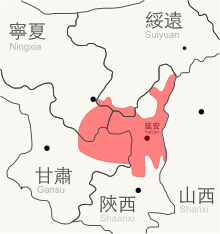Jin-Cha-Ji Border Region
This article has multiple issues. Please help improve it or discuss these issues on the talk page. (Learn how and when to remove these template messages)
|
| Shanxi-Chahar-Hebei Border Region 晉察冀邊區 | |||||||||
|---|---|---|---|---|---|---|---|---|---|
| Border Region of China | |||||||||
| 1937–1950 | |||||||||
 Map of Jin-Cha-Ji Border Region. | |||||||||
| Capital | Yan'an (1937–45) Zhangjiakou (1945–50) | ||||||||
| Historical era | Chinese Civil War | ||||||||
• Established | 1937 | ||||||||
• Disestablished | 1950 | ||||||||
| |||||||||
| Today part of | |||||||||
The Shanxi-Chahar-Hebei Border Region, frequently abbreviated at the Jin-Cha-Ji Border Region (traditional Chinese: 晉察冀邊區; simplified Chinese: 晋察冀边区; pinyin: Jìn-Chá-Jì Biānqū), was an area under the control of the Chinese Communist Party during the time of the Chinese Communist Revolution.
After their success in the Battle of Pingxingguan in September 1937, in October 1937, the 115th Division of the Eighth Route Army was ordered to occupy the Mount Wutai area of Shanxi in order to set up an Anti-Japanese Base Area.[citation needed]
Naming[edit]
This was called the Shanxi-Chahar-Hebei Anti-Japanese Base Area,[1] often referred to as a communist Border Area or Liberated Area. The abbreviated names of the three provinces were often used to describe the area, thus it was known as Jin-Cha-Ji in modern transliteration. In older Western literature it was often called Chin-Cha-Ki. Note that the term Border Area was used in official descriptions, for example, the postal service, set up in November 1937, was named the Shanxi-Hebei-Chahar Border Area Provisional Post.[2] (Renamed the Shanxi-Chahar-Hebei Border Area Provisional Post in January 1938).
History[edit]
This section needs expansion. You can help by adding to it. (July 2023) |
After Japan's fall 1938 victory in the Battle of Wuhan, its forces advanced deep into Communist territory and redeployed 50,000 troops to the Shanxi-Chahar-Hebei Border Region.[3]: 122 Elements of the Eighth Route Army soon attacked the advancing Japanese, inflicting between 3,000 and 5,000 casualties and resulting in a Japanese retreat.[3]: 122
During the Second Sino-Japanese War, the Communist Party built a broader coalition in the Shanxi-Chahar-Hebei Border Region.[3]: 128 Its land policies were more moderate than during other periods, focusing on rent and interest rate deductions.[3]: 128 Implementation of these reforms accelerated following 1943.[3]: 128
Following the May 4, 1946 Instructions on Land Issues issued by the Communist Party, instructions for implementing the instructions in the Shanxi-Chahar-Hebei Border Region stated that the intent was to achieve land to the tiller rather than equal redistribution.[3]: 137
At the beginning of the Chinese Civil War in 1946, large Nationalist forces entered the Shanxi-Chahar-Hebei Border Region.[3]: 163 Although information on the extent of territory controlled by the Nationalists during this period is not clear, one Communist report indicates that by October 1946, the Nationalists and their allies controlled or contested 45% of villages in the region.[3]: 163 This decreased to approximately 35% by February 1947.[3]: 163
In April 1947, the Shanxi-Chahar-Hebei Border Region began a Land Reinvestigation Movement in which poor peasant mass organizations investigated and adjusted the results of land distribution during the Second Sino-Japanese War.[3]: 139 During this Land Reinvestigation Movement, it was mandated that landlords could not be completely dispossessed of land unless they had collaborated with the Japanese invaders or defected to the Nationalists.[3]: 139 It was also mandated that the interests of middle peasants could not be violated.[3]: 139
Concluding that most peasants were satisfied with the land they had received and that some were even concerned about further mass land reform campaigns because of their radical turns in the past, in June 1948, the Communist Party ended land reform in the Border Region and in northern China generally with the exception of an area of approximately ten million people.[3]: 149
By late 1948, the Nationalists' conventional armed forces had been ejected from the region, although Nationalist-affiliated militia remained active thereafter.[3]: 136
Media[edit]
The Communist Party's Shanxi-Chahar-Hebei Border Region Committee had an official newspaper, the Shanxi-Chahar-Hebei Daily.[3]: 145
Armed forces[edit]
When the Chinese Civil War began after the defeat of the Japanese, the Shanxi-Chahar-Hebei Field Army had more than 180,000 soldiers. It later merged with other forces into the 234,000 soldier North China Field Army.[3]: 158
Militias in the Shanxi-Chahar-Hebei Border Region included several thousand militia members per county, sometimes as many as 10,000 or 25,000.[3]: 158
References[edit]
- ^ "People's Daily Online -- The Eighth Route Army's annals of war". en.people.cn.
- ^ Meiso Mizuhara, Catalog of the Chinese Liberation Area Stamps ISBN 4-88963-403-7 (in Japanese), also (in Chinese) and (in English)
- ^ a b c d e f g h i j k l m n o p q Opper, Marc (2020). People's Wars in China, Malaya, and Vietnam. Ann Arbor: University of Michigan Press. doi:10.3998/mpub.11413902. ISBN 978-0-472-90125-8. JSTOR 10.3998/mpub.11413902. S2CID 211359950.
